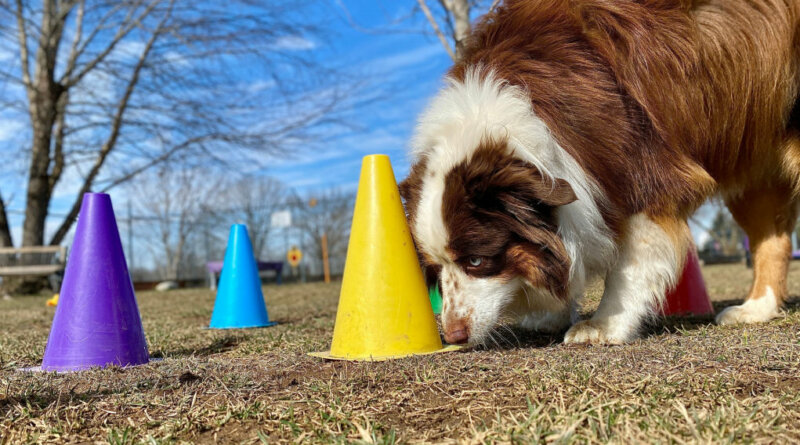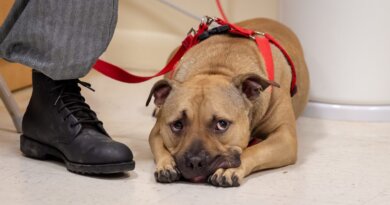Dog Daycare for Anxious Dogs – Top Dog Tips
When you picture a dog daycare, you likely imagine a group of dogs running, playing, or relaxing after a morning of fetch.
It’s close to an idyllic picture of what many dog owners assume dog daycare is for their puppy.
Whether you’re in the early stages of planning or need to find arrangements for your dog during the day, deciding on a dog daycare isn’t to be taken lightly.
Well-run dog daycares will carefully consider the dogs they currently have in their playgroup and ensure all dogs in their care are having fun.
Safety is likely a top priority for these groups, but behavioral and emotional well-being is another consideration.
Thankfully, a few training or management techniques can help the group environment, but many behaviors are challenging to manage or train.
This difficulty is compounded when many dogs are within the same environment.
Before deciding whether your dog would work well in a daycare environment, follow this guide to determine which temperaments do best in a group setup.
How to Determine Whether Your Dog Will Do Well in Daycare?
Looking at Your Dog’s Sociability Toward Other Dogs
Does your dog enjoy playing and interacting with unfamiliar dogs, or will they simply tolerate it?
If your dog shows signs they prefer the company of one or two playmates instead of a giant pack, there’s a chance you’ll want to reconsider a large playgroup.
Many well-intentioned dog owners will put their dog in a center, thinking it will do well, simply because it’s a pack environment.
Unfortunately, canines that don’t enjoy group play would likely feel anxiety, stress, or fear.
Understanding Sociability Changes
Just as human social interactions change throughout the years, a dog’s sociability shifts too.
For example, younger children enjoy playing with large groups of children, meeting new people, and going to loud parties.
As people continue to age, their social circle shifts. Smaller gatherings or intimate settings may become preferable.
It can remain the same for dogs, shifting from large, rowdy groups to smaller packs of dogs.
If you’ve recently adopted a new furry companion, you may not know how your pet might respond to other dogs.
Anyone that’s taken their dog to a dog park or leash-free would have a decent idea of how your dog might be around others.
Suppose the daycare staff informs you the pup didn’t enjoy their time, or your dog exhibits behaviors that prevent them from attending further.
In that case, it can still live a fulfilling life without socialization in this manner.
Types of Dog Personalities
Social Dog
A social dog loves virtually all other dogs. Even loud, boisterous, or obnoxious dogs can still engage with others.
A social dog tends to respond well to daycare or group play environments but monitors whether they’re causing stress to other dogs.
Many puppies start at this level, but occasionally, adult dogs are in this category.
Typically, dogs age out of this category by around six to twelve months, depending on the breed.
Alternatively, dogs shift out of this category when a negative experience creates a negative association with interactions.
Tolerant Dog
The dogs will typically do well in a daycare environment.
These canines will get along with other dogs but are often subdued at all excitement levels.
Properly socialized adult dogs will settle into this category. A tolerant dog becomes a good communicator, responding well to body language cues.
These dogs prefer avoiding confrontation and using appropriate correction for rude behaviors by other dogs.
Pups in this category will do well in various setups, so try to find one that supports your dog while maintaining adequate levels of socialization.
Selective Dog
A selective dog is fussy when it comes to dogs they react well with.
Most often, these dogs will have well-matched dog friends but frequently need help meeting unfamiliar canines.
A selective dog will prefer a specific type of energy or play style. Unfortunately, these dogs don’t respond well to inappropriate or rude behaviors.
This personality can become problematic in daycare, primarily when not adequately managed or matched.
A few daycare setups can make these dogs more nervous or stressed, pushing them into the final category.
Dogs within this category should use smaller daycare groups, offering constant supervision and consistent playmates.
Pre-planned playdates with known playmates may be enough to provide your dog interaction.
Aggressive Dog
An aggressive dog isn’t inherently “bad,” as most aggressive behavior starts with insecurity and fear.
These dogs don’t enjoy the company of unknown dogs, often making it clear with lunging, snapping, and loud barking.
These behaviors tell other dogs to leave them alone and go away.
Although an aggressive dog will periodically do well with one or two dog companions, they don’t frequently do well in large group settings.
Dogs with aggression shouldn’t enroll in a daycare environment, as minimal behavior modification can occur at this level.
Avoid putting your dog in a scary or vulnerable position.
Aggressive dogs should work with a professional dog trainer or behaviorist who can help the dog with counter-conditioning and positive reinforcement.
Understanding Dog Anxiety
Dog anxiety can stem from various sources, with the most common causes arising from separation, aging, or fear.
Separation anxiety affects approximately 14 percent of dogs, where dogs find it largely uncomfortable when left alone or separated from family members.
Anxiety will typically manifest in extreme behaviors like barking, digging, destroying furniture, or urinating in the house.
Dogs affected by CDS often have declining learning, memory, and awareness.
Unfortunately, this often leads to confusion and anxiety in senior dogs.
Age-related anxiety will impact older dogs and is often associated with cognitive dysfunction syndrome.
Visual stimuli, strange people or animals, or loud noises trigger fear-related anxiety.
It often correlates with strange environments and specific situations (like car rides or vet offices).
Although a few dogs only have brief reactions to stimuli, it may influence anxious dogs more.
Anxiety Symptoms in Dogs
Determining whether your dog has anxiety is essential before registering for daycare programs.
Symptoms may occur from anxiety-causing events but can become recurrent and more severe over time.
The most acute symptoms include:
- Drooling
- Aggression
- Pacing
- Restlessness
- Repetitive or compulsive behaviors
- Destructive behavior
- Drooling
- Excessive barking
The most dangerous symptom of dog anxiety is aggression.
Aggression can remain targeted directly or indirectly, depending on the circumstance.
Direct aggression occurs when a dog reacts toward dogs, people, or other animals.
Indirect aggression is equally dangerous, often happening when an unintended party is the recipient of aggression when getting between the dog and the source of the dog’s aggression (for example, another dog).
Aggressive actions like barking or growling can lead to undesirable situations even when a dog doesn’t physically harm others.
Treating Dog Anxiety
The most effective method of treatment is speaking directly with your veterinarian.
A veterinarian can help dog owners identify the type of anxiety their dog has, including possible triggers and causes.
The veterinarian can then determine whether the issue is situational or if it’s becoming overwhelming.
Finally, a qualified professional can rule out medical conditions.
Is Dog Daycare Good for Anxiety?
Daycare settings can be a fabulous solution for some dogs suffering from separation anxiety.
The environment offers plenty of supervision, exercise, routine, and socialization.
These four items are an excellent way to help dogs conquer anxiety.
Establishing a Routine
While the daycare environment may take adjusting, getting into the routine is a great way to soothe your dog’s anxiety.
The dog will ultimately learn what happens each day, which becomes a predictable way to offset being left alone.
Ability to Socialize
Socializing gives your dog the opportunity to interact with other humans and dogs throughout the day, distracting them from missing you.
All staff members are trained to help dogs with healthy and positive interactions, pairing them with similar sizes and activity levels.
Staff will monitor the play sessions to ensure all dogs are playing nicely.
If you’re nervous about introducing your dog to the daycare facility, contact the staff about your concerns.
The team will give you the details and help determine whether your pup needs to work on basic manners.
Maintain Regular Exercise and Activity
Occasionally, exercise is the perfect solution to your dog’s anxiety. Taking your dog to a daycare center offers plenty of exercise and activity.
This activity includes many health benefits, including lower stress, active joints, and maintaining a healthy weight.
Regular exercise also helps them burn excess energy that could manifest as anxiety.
Choosing Whether Doggy Daycare is Right for Your Dog
Daycare options will only solve separation-anxiety issues after some time, mainly if your dog is triggered by leaving.
Unfortunately, a dog will remain anxious when you leave them at daycare, requiring time to adapt to the new routine.
There is always the chance your dog is simply not into doggy daycare.
Understanding Greeting Habits of Dogs
All dogs develop a unique routine when greeting other dogs.
Although many habits will shift between confident and bold, others may remain skittish and shy.
These dogs can range in behaviors, but all show a highly uncertain demeanor.
Greetings that start with rolling over on their back, urinating a little, or nervously wagging their tail low are all shy.
Occasionally, you’ll see a pup run for the far side of a center, approaching staff nervously, or hiding under the structures at the daycare.
Sometimes, you’ll witness a snapping turtle behavior, with dogs snapping at passing dogs and tucking back into their safe zone (typically under something).
Most often, these dogs require one-on-one training to acclimate to daycare centers.
Essential Considerations for Dog Daycare and Anxiety
Emotion and Animal Size
The emotion of a dog does not depend on the animal’s size.
Just because the behavior isn’t bothersome or troubling to the owner doesn’t mean it’s acceptable to the facility.
Behavioral Changes to Other Dogs
Daycare offers unique situations of seeing dogs frequently. As such, behavior toward dogs at home or in public may change.
It’s normal for a dog to remain friendly and boisterous but may develop more confidence when approaching new dogs.
Mix of Willingness and Hesitance in Dogs
A few dogs will seem conflicted when at the daycare facility.
Behaviors and signals may suggest a willingness to play mixed submission.
These dogs will approach dogs with a desire to play and then suddenly roll on their back and submit to dogs in the area.
Defensive Behavior in Dogs
Some dogs are overly obnoxious and can become defensive. These dogs run at others fast and forcefully, often running into dogs without regard.
Many will act irritated and put off when facing similar personalities. Behaviors may include hackles raised, moving quickly, and posturing.
Hides Most of the Time
A few dogs will avoid the entire playgroup, opting to hide in the corner and disengage with playtime.
These dogs will approach and wiggle at attendants or staff while sniffing dogs that approach.
This personality won’t engage or initiate when other dogs try to play.
Avoids Humans and Other Dogs
A scared dog won’t allow dogs or humans to approach or engage. Actions might include heavy panting, wide eyes, looking around, or darting.
These dogs are terrified of the playgroup and don’t understand or enjoy being there.
Dog Daycare for Anxious Dogs: Conclusion
Dog daycare must promote a safe and healthy environment for dogs in care, but it’s not essential for a dog’s well-being.
Too many dog owners believe they don’t have options outside a daycare center when caring for their dog.
They don’t want to cause stress or harm to others, especially if the dog seems unhappy in the environment.
For those dogs who enjoy the time away from home, daycare connects your dog with crucial aspects of anxiety.
Socialization, exercise, and play throughout the day may lessen anxiety and stress.
Finding methods and tactics to improve your dog’s mood can help with anxiety levels, especially when the dog suffers from separation anxiety.
Dog daycares are an optimal socialization tool for dog owners, assuming their pup enjoys the experience.
Unfortunately, this atmosphere isn’t an ideal fit for all dogs, but it can be worth investigating for owners wanting to alleviate the common symptoms of anxiety.
READ NEXT: Is Dog Daycare Good For Dogs?
Related











